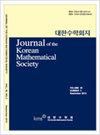由两个元生成的具有weierstrass半群的弱伽罗瓦- weierstrass点的个数
IF 0.5
4区 数学
Q2 MATHEMATICS
引用次数: 2
摘要
设C为特征为0的代数闭域上的一个属≥2的非奇异投影曲线。对于C中的点P,定义Weierstrass半群H(P)为非负整数n的集合,其中C上存在一个有理函数f,使得f在P处的极点阶等于n,且f是远离P的正则函数。如果P是Weierstrass点,且存在伽罗瓦态射φ: C→P1,使得P是φ的全分支点,则将C中的点P称为弱伽罗瓦-Weierstrass点。本文研究了由两个正整数生成Weierstrass半群的弱Galois-Weierstrass点的个数。本文章由计算机程序翻译,如有差异,请以英文原文为准。
NUMBER OF WEAK GALOIS-WEIERSTRASS POINTS WITH WEIERSTRASS SEMIGROUPS GENERATED BY TWO ELEMENTS
Let C be a nonsingular projective curve of genus ≥ 2 over an algebraically closed field of characteristic 0. For a point P in C, the Weierstrass semigroup H(P ) is defined as the set of non-negative integers n for which there exists a rational function f on C such that the order of the pole of f at P is equal to n, and f is regular away from P . A point P in C is referred to as a weak Galois-Weierstrass point if P is a Weierstrass point and there exists a Galois morphism φ : C → P1 such that P is a total ramification point of φ. In this paper, we investigate the number of weak Galois-Weierstrass points of which the Weierstrass semigroups are generated by two positive integers.
求助全文
通过发布文献求助,成功后即可免费获取论文全文。
去求助
来源期刊
CiteScore
1.20
自引率
16.70%
发文量
0
审稿时长
6-12 weeks
期刊介绍:
This journal endeavors to publish significant research of broad interests in pure and applied mathematics. One volume is published each year, and each volume consists of six issues (January, March, May, July, September, November).

 求助内容:
求助内容: 应助结果提醒方式:
应助结果提醒方式:


